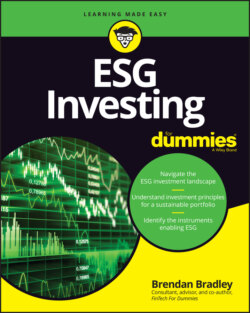Читать книгу ESG Investing For Dummies - Brendan Bradley - Страница 3
ESG Investing For Dummies® To view this book's Cheat Sheet, simply go to www.dummies.com and search for “ESG Investing For Dummies Cheat Sheet” in the Search box. Table of Contents
Оглавление1 Cover
2 Title Page
3 Copyright
4 Introduction About This Book Foolish Assumptions Icons Used in This Book Beyond the Book Where to Go from Here
5 Part 1: Getting to Know ESG Chapter 1: Entering the World of ESG Investing Surveying the Current ESG Landscape Exploring What ESG Is (and Isn’t) Understanding ESG’s Impact on the Environment, Society, and Governance Using International Standards to Determine ESG Objectives Chapter 2: Back to the Future: Understanding the Evolution and Growth of ESG Investing Studying the Evolution of Investing in ESG Exploring the “Personality” of an ESG Company Understanding Why ESG Is Important Surveying Specific ESG Ratings and Metrics Defining an ESG Policy Chapter 3: Give Me an ‘E’! Defining the Environmental Sector in ESG Outlining a Company’s Use of Natural Resources Studying the Effects of a Company’s Operations on the Environment Defining “Green” for a Company Detailing a Company’s Performance as a Steward of the Physical Environment Chapter 4: Give Me an ‘S’! Investigating the Social Aspects of ESG Identifying Factors in a Company’s Social Performance Evaluating a Company’s Social Performance Determining Measurements for Social Performance Deciding on Weight Factors Chapter 5: Give Me a ‘G’! Decoding the Governance Component of ESG The Good Place: Defining What “Good” Corporate Governance Looks Like Walk the Walk: Evaluating a Company’s Governance Values Lead the Way: Emphasizing How ‘G’ Can Dictate the ‘E’ and ‘S’ Factors Around the World: Underlining Regional Differences in Governance Activities Chapter 6: Highlighting Corporate Greenwashing The Grass Isn’t Always Greener: The Basics of Greenwashing Just When You Thought It Was Safe: Coronawashing
6 Part 2: Investing in ESG through Different Instruments Chapter 7: Approaches to ESG Investing Understanding Socially Responsible Investing Evaluating Impact Investing Focusing on Faith-Based Investing Chapter 8: Analyzing Equity-Based Instruments Integrating ESG Strategies into Investment Decisions Verifying Quantitative Strategies Identifying Smart Beta Strategies Focusing on a Given Theme Chapter 9: ESG and Fixed Income Instruments Analyzing Fixed Income (Bond) Factors Emphasizing Bond Issuer Differences Highlighting Fixed Income Indexes Identifying Specific ESG Exposures Chapter 10: Exploring Derivative and Alternative Instruments Achieving Passive Returns Using ESG Indexes Increasing Focus on ESG in Alternative Assets Focusing on Illiquid Assets Investing in “Traditional” ESG Chapter 11: Highlighting Geographical Differences in ESG Investing The Beginning: Europe The Middle: North America The End: Developed versus Emerging Markets
7 Part 3: Applying ESG Philosophy Chapter 12: Creating Value through ESG for Corporations Crystal Clear: Corporate Disclosure and Transparency Grow the Pie: Generating Enhanced Returns Roll Up, Roll Up: Attracting More Customers Pare It Back: Reducing Costs The Bottom Line: Increasing Productivity and Attracting Talent Chapter 13: Devising an ESG Policy Here’s a Great Idea: Creating a Plan Don’t Reinvent the Wheel: Undertaking a Peer Review Go Over It: Reviewing Your Core Investment Principles Familiarizing Yourself with ESG-Specific Regulations Surveying Reporting Requirements Examining ESG Engagement Chapter 14: Defining and Measuring ESG Performance and Reporting Defining Criteria and Metrics Calculating Relative ESG Performance Getting a Handle on Ratings and Rankings Developing Frameworks for Reporting Chapter 15: Elaborating the ESG Endgame Highlighting the Evolution of ESG from Niche to Mainstream Strategy Watching the Growing Use and Acceptance of ESG Standards Looking at the Increasing Impact of ESG Ratings and Rankings Improving Education
8 Part 4: The Part of Tens Chapter 16: Ten Frequently Asked Questions for an ESG Approach What Is ESG Investing? Which Sustainability Goals Should Be Followed? What Are the Characteristics of an ESG Company? How Is an ESG Company Rated? What Investing Principles Should Be Adopted for ESG? What Is Stewardship? How Is an ESG Approach for Asset Owners Implemented? How Are Benchmarks and Performance Measurement Incorporated in ESG? What’s the Latest on Disclosures and Reporting? What’s the Future of ESG Investing? Chapter 17: Ten Issues Surrounding ESG Portfolio Construction Reasons for Varying ESG Scores between Rating Agencies Criteria Used in Creating a Combined ESG Score Trends Driving ESG Materiality Quantitative Approaches to ESG Analysis Qualitative Analysis: Verifying and Supplementing Quantitative Analysis ESG Regulations Risk and Reward Derivative and Alternative Instruments Stranded Assets Sustainable Investing Chapter 18: Ten Factors Influencing the Growth of ESG Investing Climate Change: The Route to Net Zero Environmental and Social Issues Coming to the Fore Stewardship as a Driver for Change ESG Disclosures Accounting Regulation and International Standards Impact Investing: Actively Do Good versus “Do No Harm” Data and Technology Consolidation of the ESG Ratings Companies Political Impacts: Geopolitics and Public Pressure
9 Appendix: Great Resources for ESG Investing The Basics of Building a Retail ESG Portfolio Disclosure, Reporting, and Engagement Further Asset Class Information
10 Index
11 About the Author
12 Advertisement Page
13 Connect with Dummies
14 End User License Agreement
